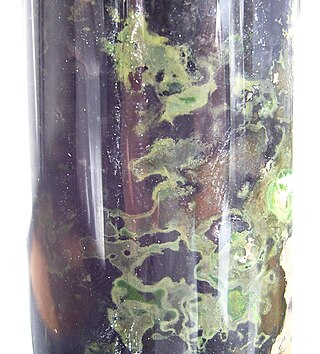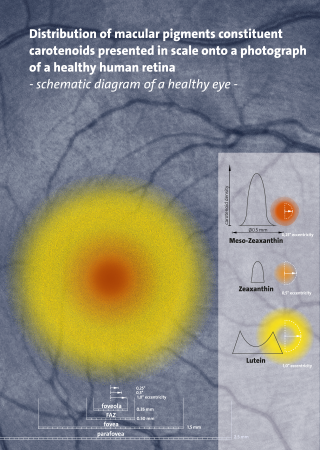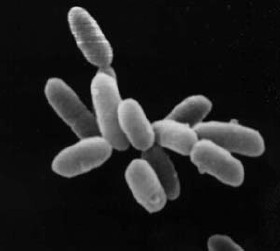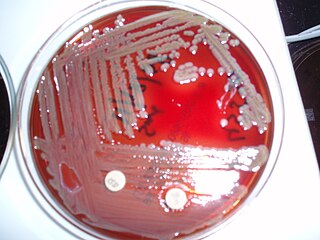
The term carotene (also carotin, from the Latin carota, "carrot") is used for many related unsaturated hydrocarbon substances having the formula C40Hx, which are synthesized by plants but in general cannot be made by animals (with the exception of some aphids and spider mites which acquired the synthesizing genes from fungi). Carotenes are photosynthetic pigments important for photosynthesis.

The green sulfur bacteria are a phylum, Chlorobiota, of obligately anaerobic photoautotrophic bacteria that metabolize sulfur.

Carotenoids are yellow, orange, and red organic pigments that are produced by plants and algae, as well as several bacteria, archaea, and fungi. Carotenoids give the characteristic color to pumpkins, carrots, parsnips, corn, tomatoes, canaries, flamingos, salmon, lobster, shrimp, and daffodils. Over 1,100 identified carotenoids can be further categorized into two classes – xanthophylls and carotenes.

The phylum Bacteroidota is composed of three large classes of Gram-negative, nonsporeforming, anaerobic or aerobic, and rod-shaped bacteria that are widely distributed in the environment, including in soil, sediments, and sea water, as well as in the guts and on the skin of animals.

Chromoplasts are plastids, heterogeneous organelles responsible for pigment synthesis and storage in specific photosynthetic eukaryotes. It is thought that like all other plastids including chloroplasts and leucoplasts they are descended from symbiotic prokaryotes.

Xanthophylls are yellow pigments that occur widely in nature and form one of two major divisions of the carotenoid group; the other division is formed by the carotenes. The name is from Greek: xanthos (ξανθός), meaning "yellow", and phyllon (φύλλον), meaning "leaf"), due to their formation of the yellow band seen in early chromatography of leaf pigments.

Astaxanthin is a keto-carotenoid within a group of chemical compounds known as carotenones or terpenes. Astaxanthin is a metabolite of zeaxanthin and canthaxanthin, containing both hydroxyl and ketone functional groups.

Purple bacteria or purple photosynthetic bacteria are Gram-negative proteobacteria that are phototrophic, capable of producing their own food via photosynthesis. They are pigmented with bacteriochlorophyll a or b, together with various carotenoids, which give them colours ranging between purple, red, brown, and orange. They may be divided into two groups – purple sulfur bacteria and purple non-sulfur bacteria. Purple bacteria are anoxygenic phototrophs widely spread in nature, but especially in aquatic environments, where there are anoxic conditions that favor the synthesis of their pigments.

Haloarchaea are a class of prokaryotic archaea under the phylum Euryarchaeota, found in water saturated or nearly saturated with salt. 'Halobacteria' are now recognized as archaea rather than bacteria and are one of the largest groups or archaea. The name 'halobacteria' was assigned to this group of organisms before the existence of the domain Archaea was realized, and while valid according to taxonomic rules, should be updated. Halophilic archaea are generally referred to as haloarchaea to distinguish them from halophilic bacteria.

Biological pigments, also known simply as pigments or biochromes, are substances produced by living organisms that have a color resulting from selective color absorption. Biological pigments include plant pigments and flower pigments. Many biological structures, such as skin, eyes, feathers, fur and hair contain pigments such as melanin in specialized cells called chromatophores. In some species, pigments accrue over very long periods during an individual's lifespan.
γ-Carotene (gamma-carotene) is a carotenoid, and is a biosynthetic intermediate for cyclized carotenoid synthesis in plants. It is formed from cyclization of lycopene by lycopene cyclase epsilon. Along with several other carotenoids, γ-carotene is a vitamer of vitamin A in herbivores and omnivores. Carotenoids with a cyclized, beta-ionone ring can be converted to vitamin A, also known as retinol, by the enzyme beta-carotene 15,15'-dioxygenase; however, the bioconversion of γ-carotene to retinol has not been well-characterized. γ-Carotene has tentatively been identified as a biomarker for green and purple sulfur bacteria in a sample from the 1.640 ± 0.003-Gyr-old Barney Creek Formation in Northern Australia which comprises marine sediments. Tentative discovery of γ-carotene in marine sediments implies a past euxinic environment, where water columns were anoxic and sulfidic. This is significant for reconstructing past oceanic conditions, but so far γ-carotene has only been potentially identified in the one measured sample.

The class Flavobacteriia is composed of a single class of environmental bacteria. It contains the family Flavobacteriaceae, which is the largest family in the phylum Bacteroidota. This class is widely distributed in soil, fresh, and seawater habitats. The name is often spelt Flavobacteria, but was officially named Flavobacteriia in 2012.

Flavobacterium columnare is a thin Gram-negative rod bacterium of the genus Flavobacterium. The name derives from the way in which the organism grows in rhizoid columnar formations.

Columnaris (also referred to as cottonmouth and saddle-back disease) is a disease in fish which results from an infection caused by the Gram-negative, aerobic, rod-shaped bacterium Flavobacterium columnare. It was previously known as Bacillus columnaris, Chondrococcus columnaris, Cytophaga columnaris and Flexibacter columnaris. The bacteria are ubiquitous in fresh water, and cultured fish reared in ponds or raceways are the primary concern – with disease most prevalent in air temperatures above 12–14 °C. Due to the appearance of bacterial clumps, it can be mistaken for a fungal infection. The disease is highly contagious, and the outcome is commonly fatal. It is not zoonotic.

Pulvinone, an organic compound belonging to the esters, lactones, alcohols and butenolides classes, is a yellow crystalline solid. Although the pulvinone is not a natural product, several naturally occurring hydroxylated derivatives are known. These hydroxylated pulvinones are produced by fungal species, such as the in Europe common Larch Bolete, or by moulds such as Aspergillus terreus.
Aerobic anoxygenic phototrophic bacteria (AAPBs) are Alphaproteobacteria and Gammaproteobacteria that are obligate aerobes that capture energy from light by anoxygenic photosynthesis. Anoxygenic photosynthesis is the phototrophic process where light energy is captured and stored as ATP. The production of oxygen is non-existent and, therefore, water is not used as an electron donor. They are widely distributed marine bacteria that may constitute over 10% of the open ocean microbial community. They can be particularly abundant in oligotrophic conditions where they were found to be 24% of the community. Aerobic anoxygenic phototrophic bacteria are photoheterotrophic (phototroph) microbes that exist in a variety of aquatic environments. Most are obligately aerobic, meaning they require oxygen to grow. One aspect of these bacteria is that they, unlike other similar bacteria, are unable to utilize BChl (bacteriochlorophyll) for anaerobic growth. The only photosynthetic pigment that exists in AAPB is BChl-a. Anaerobic phototrophic bacteria, on the contrary, can contain numerous species of photosynthetic pigments like bacteriochlorophyll-a. These bacteria can be isolated using carotenoid presence and medias containing organic compounds. Predation, as well as the availability of phosphorus and light, have been shown to be important factors that influence AAPB growth in their natural environments. AAPBs are thought to play an important role in carbon cycling by relying on organic matter substrates and acting as sinks for dissolved organic carbon. There is still a knowledge gap in research areas regarding the abundance and genetic diversity of AAPB, as well as the environmental variables that regulate these two properties.
Okenane, the diagenetic end product of okenone, is a biomarker for Chromatiaceae, the purple sulfur bacteria. These anoxygenic phototrophs use light for energy and sulfide as their electron donor and sulfur source. Discovery of okenane in marine sediments implies a past euxinic environment, where water columns were anoxic and sulfidic. This is potentially tremendously important for reconstructing past oceanic conditions, but so far okenane has only been identified in one Paleoproterozoic rock sample from Northern Australia.
Flavobacterium akiainvivens, or koʻohonua ʻili akia, is a species of gram-negative bacteria in the Flavobacteriaceae family. The specific epithet akiainvivens is Latin and literally means "living on or in ʻākia." It was isolated originally from decaying wood of the endemic Hawai'ian shrub ʻākia.
Dokdonia is a genus of bacteria in the family Flavobacteriaceae and phylum Bacteroidota.
Cytophagales is an order of non-spore forming, rod-shaped, Gram-negative bacteria that move through a gliding or flexing motion. These chemoorganotrophs are important remineralizers of organic materials into micronutrients. They are widely dispersed in the environment, found in ecosystems including soil, freshwater, seawater and sea ice. Cytophagales is included in the Bacteroidota phylum.












